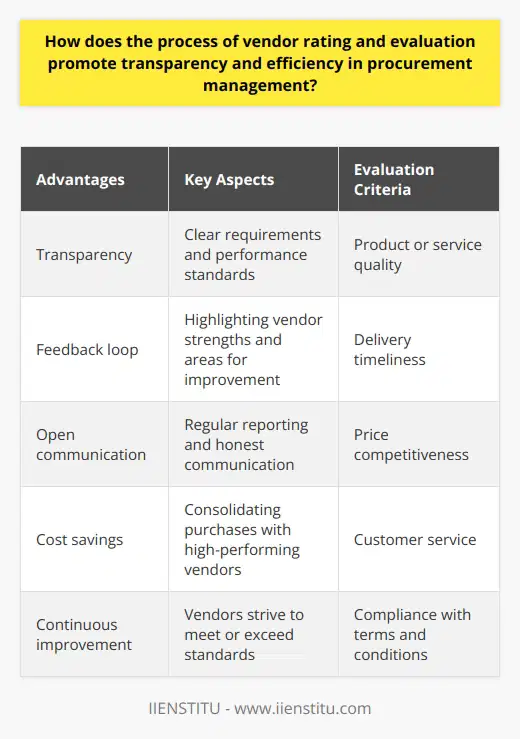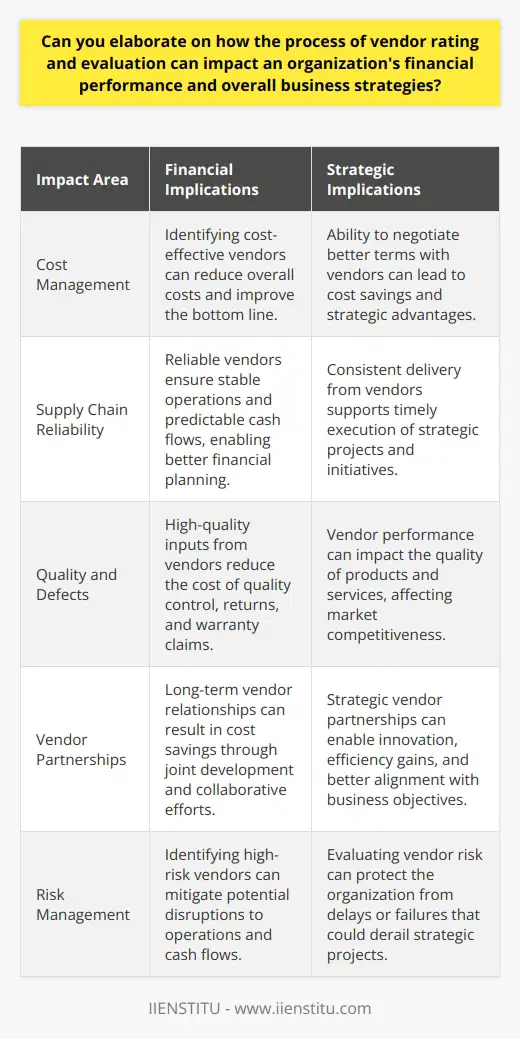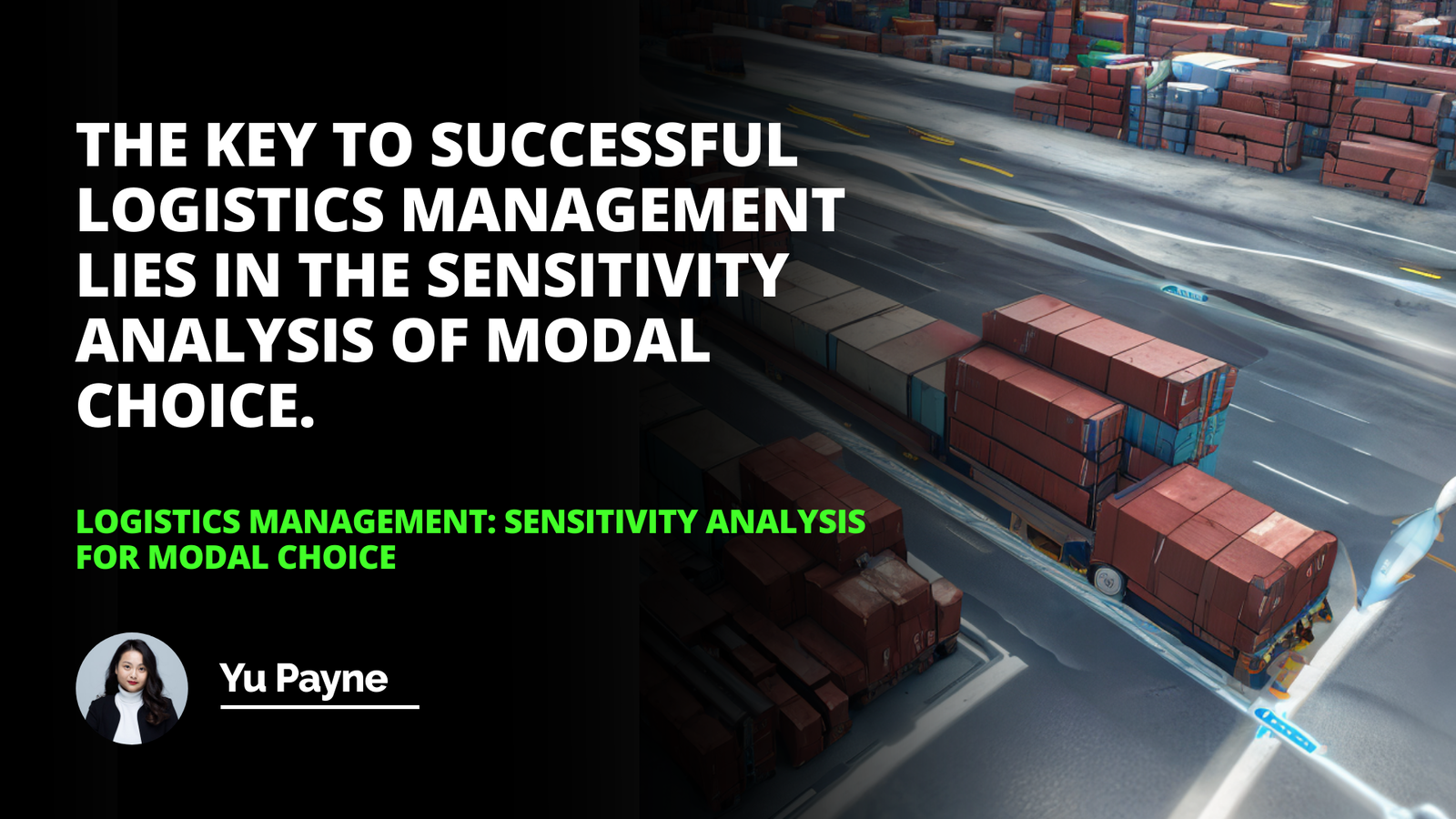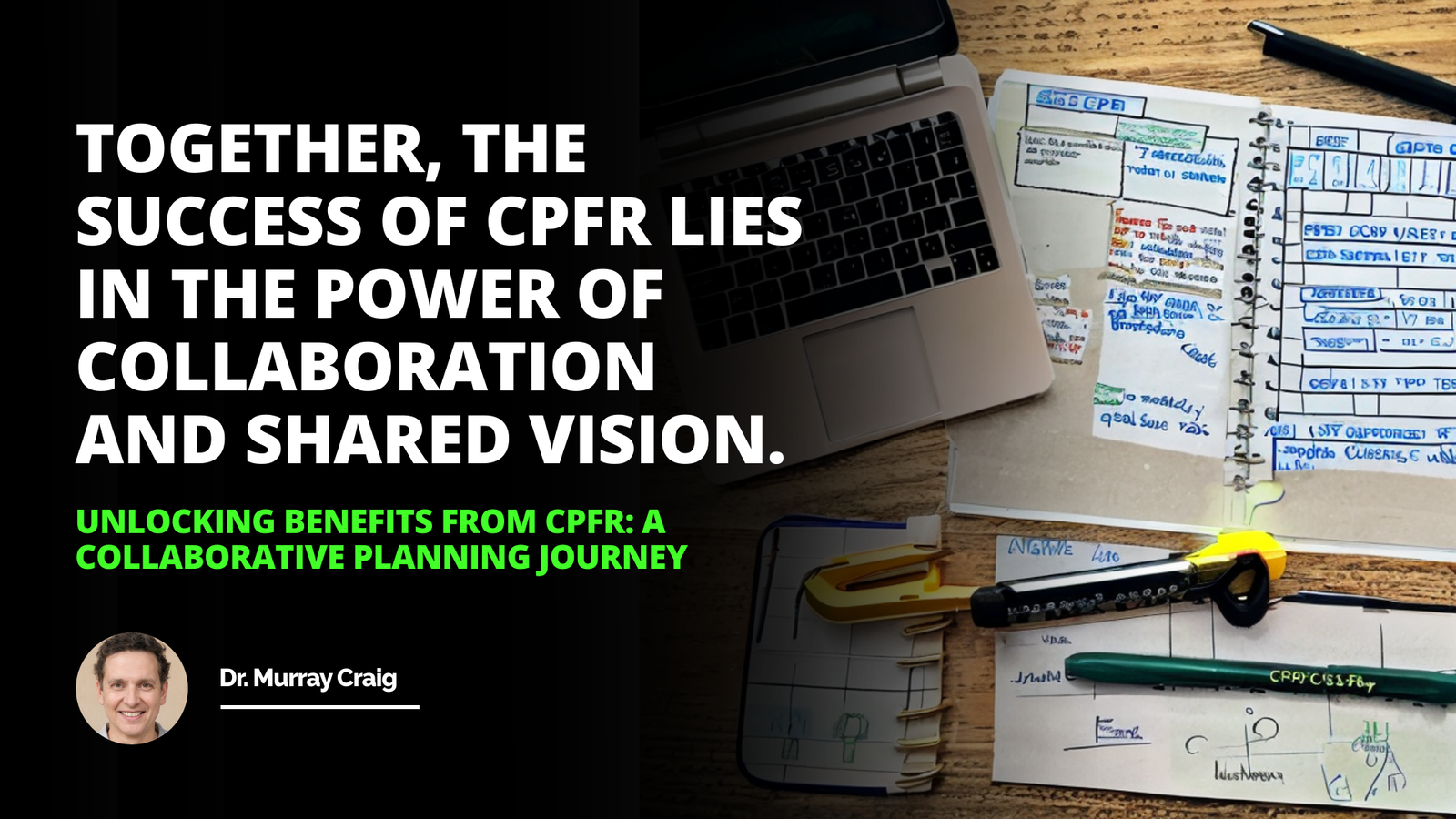
In the intricate web of modern supply chain management, the evaluation of vendors stands as a pivotal process that can dramatically influence a business's integrity, quality, and efficiency. It is a practice that transcends mere transactional exchanges to encompass a strategic assessment of suppliers' capabilities and performance.
This article endeavors to elucidate the multifaceted construct of vendor rating and evaluation, progressively unraveling its layers to deliver a comprehensive understanding that serves professionals engaged in procurement and supply chain operations. The value of such an approach, marked by rigorous and continuous appraisal, lies at the heart of operational excellence and sustainable partner relationships.
We will delve deep into the essence of this concept, examining its significance, the factors that fuel its framework, and the methodologies that fortify its implementation, providing a narrative enriched with exemplars that demonstrate its practical application in the business echelon.
Introduction
Vendor rating and evaluation stands as a critical hinge in the machinery of business partnerships, facilitating the efforts to weave a reliable and high-performing vendor base. It is a systematic approach that comprehensively appraises the potential and actual performance of suppliers through quantifiable and qualitative judgment criteria. Such an appraisal mechanism not only helps in the identification of strengths and areas for improvement but also promotes a competitive spirit among vendors, ensuring that they constantly strive for excellence. This blog aims to provide a deep understanding of the fundamentals governing vendor evaluation, guided by the knowledge that it is an instrumental tool for businesses to optimize their supply chain, and, by extension, their market performance.
In our exploration of this subject, we will unpack various segments that compose the vendor evaluation armor. Firstly, we shall define the concept and its constituents, followed by a detailed analysis of the procedures undertaken to rate and evaluate suppliers. We will consider multiple dimensions such as quality, punctuality, and cost-effectiveness, scrutinizing how each factor bears upon the overall assessment. Additionally, the exposition will navigate through the realm of developing pertinent evaluation criteria along with performance monitoring. While the advantages of meticulous vendor assessment are manifold, it is prudent to also consider potential challenges. Real-world scenarios where businesses have employed vendor evaluation strategies will be discussed before culminating this discourse with a concluding synopsis.
Understanding Vendor Evaluation and Rating
Vendor evaluation and rating signify more than a cursory glance at a supplier's past performance. It is a profound strategy that permeates the procurement function, safeguarding the interests of businesses by ensuring that suppliers can meet the standards and demands established. At its core, vendor rating is an empirical system, often merging both quantitative and qualitative analysis to gauge a vendor's abilities and adherence to contractual obligations. This practice is monumental in upholding supply chain integrity and enhancing strategic sourcing decisions.
Long Tail Keyword: Benefits Of An Mba For Career Advancement
Advanced Planning And Scheduling İn Supply Chain Optimization Strategies
Furthering the point, vendor evaluation is not merely a retrospective activity. It functions robustly as a barometer forecasting potential challenges and assisting in the management of risks associated with vendor dependence. Robust and objective vendor evaluation clamps down on the probability of performance hiccups by setting clear expectations and providing performance feedback that fosters ongoing improvement. It bears the potential to transform vendor interactions from transaction-based to collaborative, intricate business relationships.
It's not just about what suppliers have done, but also what they're capable of doing. A diversification of factors, ranging from financial stability to cultural alignment, are considered, molding a holistic view that extends beyond mere cost-saving pursuits. Because each business has distinct metrics for evaluating a vendor's compatibility with its operations, a customized approach is warranted. This customization is where the detailed nuances of vendor evaluation come to the fore.
Logistics Mgmt: System Approach to Transp, Route Plan, Mode Sel, & Vehicle Scheduling
Analyzing the Impact of Sustainable Logistics Practices on Business
Factors Pertaining to Vendor Evaluation
Quality of Goods and Services
Quality is paramount in the vendor rating. Businesses seek assurance that the goods or services procured will not just meet but surpass their requisites for quality. Vendors are often assessed on the reliability of their products, the consistency of the production and delivery processes, as well as their ability to rectify defects. Supplier quality management systems, certifications, such as logistics certification, and historical performance data play a vital role in determining these quality factors. By fostering a stringent quality-first mindset within the evaluation, businesses safeguard their operations against the incursion of substandard inputs that could otherwise undermine their product and service offerings.
Timeliness and Delivery
A vendor's punctuality and their capability to deliver on time are crucial components of vendor evaluation. Consistency in meeting delivery schedules symbolizes a supplier's operational efficiency and reliability. On-time delivery not only prevents bottlenecks in the buyer's value chain but also reinforces the robustness of inventory management.
When suppliers adhere to delivery timelines, it cultivates trust and stability within the supply chain, leading to fewer disruptions and increased operational fluency. Hence, timeliness is not simply a measure of performance but an element of strategic viability for vendor relationship management.
Cost-Effectiveness
In aligning the prospects of a supplier with those of the procuring entity, cost-effectiveness deserves significant attention. Businesses, in their pursuit of profitability, must ensure that the sourcing arrangements with vendors are financially sound, offering the best value for the investment.
Examining the suppliers' pricing strategies, understanding the total cost of ownership, and assessing market competitiveness are part of the cost-effectiveness evaluation. It is about striking an optimal balance between quality and expenditure, ensuring that cost-cutting does not come at the expense of excellence or supplier sustainability.
How to Carry Out an Effective Vendor Rating and Evaluation
An effective vendor evaluation is methodical, transparent, and aligned with organizational goals. The process typically begins with establishing clearly defined criteria that resonate with the strategic, operational, and cultural dimensions of the business. These criteria are then transformed into measurable metrics, which aid in the scoring and rating of vendor capabilities. Leveraging data-driven insights, scorecards, and performance dashboards, businesses can obtain a granular and comparative analysis of their vendors, steering informed decision-making.
Set Evaluation Criteria
The bedrock of vendor evaluation lies in setting appropriate and fair criteria that embodies business needs and quality expectations. This phase involves delineating specific targets and benchmarks that a vendor is expected to meet or exceed. The criteria should cover diverse facets such as product or service quality, delivery timeliness, innovation, sustainability, and customer service, among others. By aligning these criteria with business objectives and industry standards, companies ensure that the evaluation is comprehensive and conducive to driving supplier performance.
Monitoring and Evaluating Vendor Performance
Continuous monitoring and periodic evaluation of vendor performance are integral to maintaining a dynamic business environment. This ongoing process of assessment enables businesses to keep a pulse on the suppliers' conformity to performance standards and contractual agreements. By consistently observing and analyzing vendor actions and outcomes, companies can timely identify areas in need of intervention or improvement, fostering a culture of continuous enhancement.
Advantages and Disadvantages of Vendor Evaluation and Rating
The utility of vendor evaluation is multifold; it bolsters supply chain resilience, encourages supplier development, and perpetuates a striving for excellence. Through a well-structured vendor evaluation system, businesses can reduce risks, mitigate potential supply chain disruptions, and craft a strategic edge in a competitive marketplace. Moreover, the feedback and insights gleaned from evaluations serve as a catalyst for vendor improvement and innovation, creating a synergy that propels both the supplier and the buyer toward excellence.
Yet, vendor evaluation is not free from challenges. The process of evaluation may demand a significant investment of time and resources, and poorly managed evaluations can strain supplier relationships. The potential subjectivity and bias present in evaluating suppliers may skew results if not conducted with due rigor. Moreover, the dynamics of global supply chains, coupled with cultural and operational diversities, add layers of complexity to the evaluation exercise. It necessitates an adaptable and nuanced approach to cater to these challenges effectively.
Real-World Examples of Vendor Evaluation
There are numerous anecdotal evidences that speak to the success and necessity of vendor evaluation in the modern business landscape. Companies with a robust vendor evaluation framework, such as those with certificate courses online for supplier development, have reported higher operational efficiencies and better risk management. These real-world examples crystallize the theory into practice, showcasing measurable improvements in delivery performance, cost reductions, and heightened product innovations derived from rigorous evaluation practices.
A car manufacturer, for instance, might use a vendor rating system to select and retain suppliers who consistently meet stringent quality and delivery standards, directly impacting the quality of the final automotive product. Another example comes from the technology sector, where a tech giant evaluates its suppliers based on their ability to support rapid innovation cycles, thus fostering a collaborative environment aimed at cutting-edge development.
Vendor rating and evaluation are indispensable tools in the arsenal of modern supply chain management. Through this discourse, we have examined its imperative nature, the multifarious factors at play, and the methodologies for conducting effective evaluations. It is apparent that meticulous vendor evaluations confer substantial benefits, mitigating risks, and enhancing overall business performance. Yet, it comes with its array of potential pitfalls, which can be navigated through precise and considerate implementation. As the business environment evolves, so will the methodologies and practices of vendor evaluation, underscoring its continued relevance.
In light of what has been discussed, it is evident that businesses should not only engage in but also continually refine their vendor evaluation processes. By fostering a keen understanding and practical application of these strategies, businesses can expect to sustain and expand their competitive advantage in a complex and ever-changing global marketplace. It is an endeavor worth embarking upon, a pursuit that promises to align suppliers with the lofty ambitions of their client companies, engendering a shared journey towards success and innovation.
Frequently Asked Questions
What are the key components taken into consideration while conducting a vendor rating and evaluation?
Vendor Rating and Evaluation Criteria
Vendors play pivotal roles in business success. Organizations assess them rigorously. Evaluations prevent potential risks. They ensure contract adherence and performance optimization.
Price Competitiveness
Price remains a primary focus. Economical choices often prevail. Cost effectiveness supports budget adherence. Negotiation possibilities also factor in.
Quality of Goods and Services
Quality determines customer satisfaction. Reputable vendors maintain high standards. Standard compliance is non-negotiable. Consistency in quality is crucial.
Delivery Timeliness
Punctual delivery is imperative. Timing impacts production cycles. Late deliveries cause ripple effects. Vendors must respect agreed schedules.
Service and Support
Vendors should offer reliable support. Responsiveness signifies good customer service. Post-sale support reflects commitment. Technical assistance stands equally important.
Financial Stability
Stable vendors indicate reliability. Financial health predicts longevity. Risk assessments require financial transparency. Stability reassures trust in partnerships.
Ethical and Social Compliance
Ethical practices are essential. Social responsibility attracts conscious buyers. Compliance with laws protects businesses. Vendors should align with company values.
Technology and Innovation
Advancements dictate vendor desirability. Cutting-edge technology offers competitive advantage. Innovation shows forward thinking. Partnerships should foster growth opportunities.
Experience and Reputation
Established vendors impart confidence. Track records reveal reliability. Reputation speaks through customer feedback. Industry standing influences decision-making.
Communication Efficiency
Effective communication streamlines processes. Clarity prevents misunderstandings. Availability eases collaboration. Engaged vendors facilitate smoother transactions.
Flexibility and Adaptability
Changes occur frequently. Flexible vendors better accommodate needs. Adaptability to market dynamics is valued. Vendors must pivot when necessary.
Environmental Impact
Sustainability gains importance. Environmental footprint matters to stakeholders. Green vendors receive preference. Aligning with eco-friendly practices is beneficial.
References and Recommendations
Satisfied customers provide powerful endorsements. Positive references indicate satisfaction. Recommendations often sway evaluations. They complement objective performance metrics.
Contractual Compliance
Adherence to agreements is fundamental. Deviations cause distrust and disruption. Compliance safeguards against legal issues. It solidifies the partnership basis.
Vendor evaluations combine these components. Balanced assessments derive from multiple angles. Thorough analyses ensure beneficial collaborations. They contribute to sustainable business growth.

How does the process of vendor rating and evaluation promote transparency and efficiency in procurement management?
Vendor Rating and Evaluation
Importance in Procurement Management
Vendor rating and evaluation serve as cornerstones in procurement management. They introduce objectivity and data-backed decision-making into the procurement process. By assessing vendor performance against defined criteria, organizations ensure a transparent and efficient sourcing strategy.
Promoting Transparency
Transparency stands out as a primary advantage of vendor evaluation. Through this practice, procurement teams disseminate clear requirements. Vendors receive insights into expected performance standards. They understand the evaluation criteria. Stakeholders gain access to the evaluation outcomes. This visibility reinforces trust among all parties involved.
Evaluations create a feedback loop. They highlight vendor strengths and areas for improvement. Vendors appreciate the opportunity to understand client expectations. They can aim for better performance.
Regular reporting forms a key aspect here. Procurement departments share evaluation reports periodically. This step fosters an open environment. It encourages honest communication between all stakeholders.
Boosting Efficiency
Efficiency in procurement reflects in cost savings and optimal resource use. Vendor evaluations enable efficiency in several ways. They identify high-performing vendors. Procurement can then consolidate purchases with these vendors.
Teams streamline vendor management. They focus on those offering the best value. They reduce time spent on managing underperformers. The process paves the way for automating procurement functions. This relies on vendor performance data.
Vendor evaluations push for continuous improvement. Vendors strive to meet or exceed standards. They innovate to stay competitive. They deliver better quality goods or services. Procurement teams benefit from these advancements.
Evaluation Criteria
Criteria for vendor rating vary but often include:
- Product or service quality
- Delivery timeliness
- Price competitiveness
- Customer service
- Compliance with terms and conditions
Each criterion carries a score. Vendors earn scores based on performance. Aggregate scores reveal overall performance levels. This scoring system promotes fairness. It applies uniform standards.
Conclusion
The vendor rating and evaluation process shapes procurement management. It embeds transparency and efficiency in operations. Stakeholders witness clear, fair, and open practices. Vendors understand expectations. They strive to meet them. Procurement teams can execute streamlined, data-informed strategies.
In conclusion, this vetting process results in a well-informed, value-driven procurement function. It fosters ongoing improvements. It benefits organizations, vendors, and the procurement profession as a whole.

Can you elaborate on how the process of vendor rating and evaluation can impact an organization's financial performance and overall business strategies?
Understanding Vendor Rating and Evaluation
Organizations often overlook the importance of vendor management. Yet, it directly affects financial performance and strategic outcomes. Vendor rating and evaluation stand as critical elements of this management. They ensure suppliers meet organizational standards.
Financial Performance Implications
Vendor rating influences cost management. A vendor's ability to provide cost-effective solutions impacts the bottom line. Rigorous evaluation unearths the most financially beneficial partnerships. It can lead to negotiating better terms, thus reducing costs.
Cash flow depends on vendor reliability. Delays in supply can halt production. Efficient vendors ensure stable operations. This stability creates predictable cash flows. It therefore solidifies financial planning.
Quality of products and services links to vendor performance. High-quality inputs from vendors mean fewer defects. Reduced defects decrease the cost of quality control. They also limit returns and warranty claims.
Ratings lead to strategic vendor partnerships. Long-term partnerships can evolve from consistent high ratings. These relationships often result in cost savings. They also enable joint development of better products or services.
Business Strategy Impact
Vendor evaluation aligns suppliers with business goals. It ensures vendors support strategic objectives. This alignment leads to improved efficiency and innovation.
Risk management integrates with vendor evaluation. Vendors with poor ratings may pose a risk. Their failure to deliver can disrupt operations. High-risk suppliers can therefore derail strategic projects.
Market responsiveness grows with effective vendor management. Vendors that rapidly adapt to changes can give a company a competitive edge. Timely delivery of innovative products can keep a company ahead.
Key Takeaways
- Costs drop with effective vendor evaluation.
- Vendor reliability bolsters stable operations.
- Quality inputs from vendors cut unnecessary expenses.
- Long-standing vendor relationships bring strategic advantages.
- Aligning vendors with business objectives enhances efficiency.
- Identifying high-risk suppliers protects the organization.
In conclusion, robust vendor rating and vendor evaluation practices shape the financial health and strategic direction of an organization. They are not mere procurement functions but are integral to a company's success.



